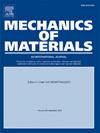Exploring forming limit of stainless steel below room temperature by Nakazima tests using an actively cooled additively manufactured punch
IF 4.1
3区 材料科学
Q2 MATERIALS SCIENCE, MULTIDISCIPLINARY
引用次数: 0
Abstract
The hardening behavior of metastable austenitic stainless steel 1.4301, which undergoes the Transformation Induced Plasticity (TRIP) effect, is influenced by various factors, including the plastic strain, the temperature, and the current martensite content. Investigating the forming limit of this material in relation to temperature is, therefore, crucial to understand its processability and determining its range of applications. Since the forming limit curve (FLC) above room temperature has been extensively studied for this stainless steel, this paper aims to provide a comprehensive theoretical-experimental investigation of the FLC slightly below room temperature. To that end, a cooled punch was designed, and the experimental setup was defined to perform isothermal Nakazima experiments at and temperatures. The modified maximum force criterion (MMFC) was applied to the experiments to predict the theoretical FLC of the stainless steel. Non-isothermal Nakazima tests were used to validate the MMFC calibration. The cooled punch with confocal cooling channels performed isothermal Nakazima tests within . The forming limit of was below the one of and the MMFC could predict the FLC and the non-isothermal paths within an overall accuracy deviation of . Through the present investigation, we found that the martensite transformation occurs too fast at to prolong the forming potential.
利用主动冷却增材制造冲床进行中岛试验,探索不锈钢在室温下的成形极限
发生相变诱发塑性(TRIP)效应的亚稳奥氏体不锈钢1.4301的硬化行为受到多种因素的影响,包括塑性应变、温度和电流马氏体含量。因此,研究这种材料的成形极限与温度的关系,对于理解其可加工性和确定其应用范围至关重要。由于室温以上的成形极限曲线(FLC)已经得到了广泛的研究,本文旨在对略低于室温的成形极限曲线进行全面的理论-实验研究。为此,设计了冷却冲床,并定义了实验装置,在0°C和20°C温度下进行等温中岛实验。将改进的最大力准则(MMFC)应用于试验,预测了不锈钢的理论极限承载力。采用非等温Nakazima试验验证MMFC校准。采用共聚焦冷却通道的冷却冲床在σ=4°C范围内进行了等温Nakazima试验。0℃的成形极限低于20℃的成形极限,MMFC预测FLC和非等温路径的总体精度偏差在4%以内。通过本研究,我们发现在0℃时马氏体转变速度过快,延长了成形势。
本文章由计算机程序翻译,如有差异,请以英文原文为准。
求助全文
约1分钟内获得全文
求助全文
来源期刊

Mechanics of Materials
工程技术-材料科学:综合
CiteScore
7.60
自引率
5.10%
发文量
243
审稿时长
46 days
期刊介绍:
Mechanics of Materials is a forum for original scientific research on the flow, fracture, and general constitutive behavior of geophysical, geotechnical and technological materials, with balanced coverage of advanced technological and natural materials, with balanced coverage of theoretical, experimental, and field investigations. Of special concern are macroscopic predictions based on microscopic models, identification of microscopic structures from limited overall macroscopic data, experimental and field results that lead to fundamental understanding of the behavior of materials, and coordinated experimental and analytical investigations that culminate in theories with predictive quality.
 求助内容:
求助内容: 应助结果提醒方式:
应助结果提醒方式:


